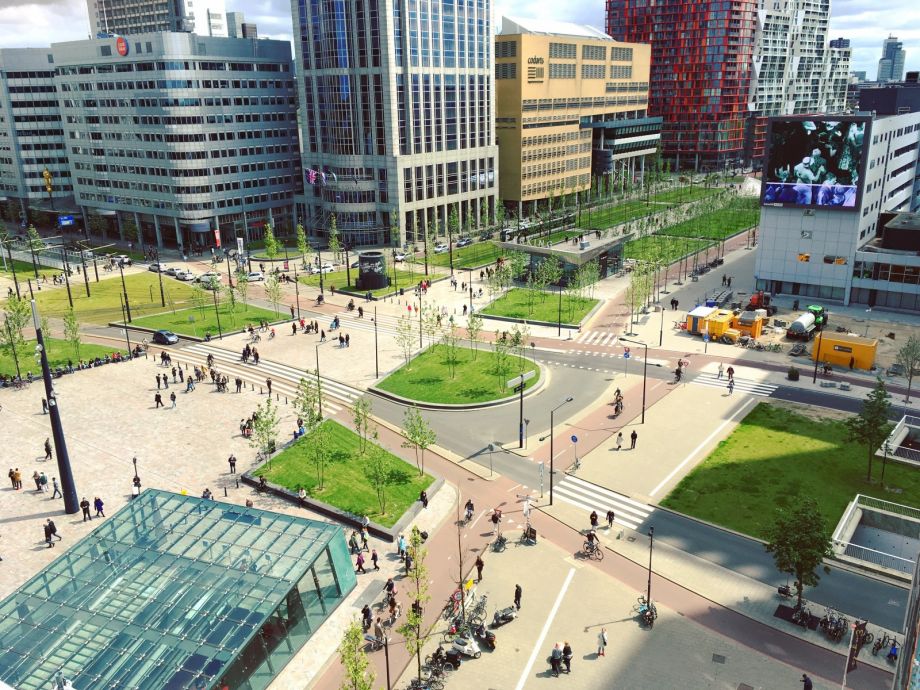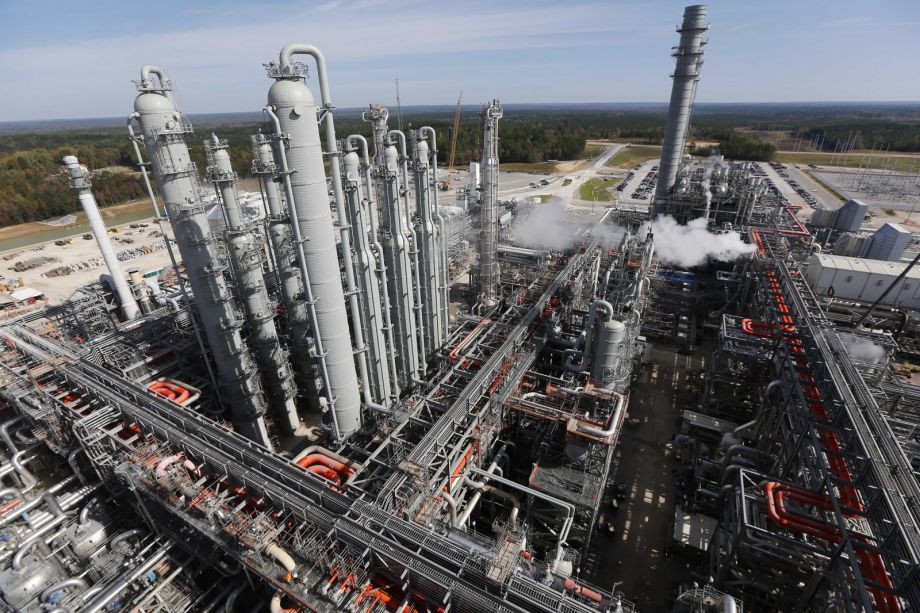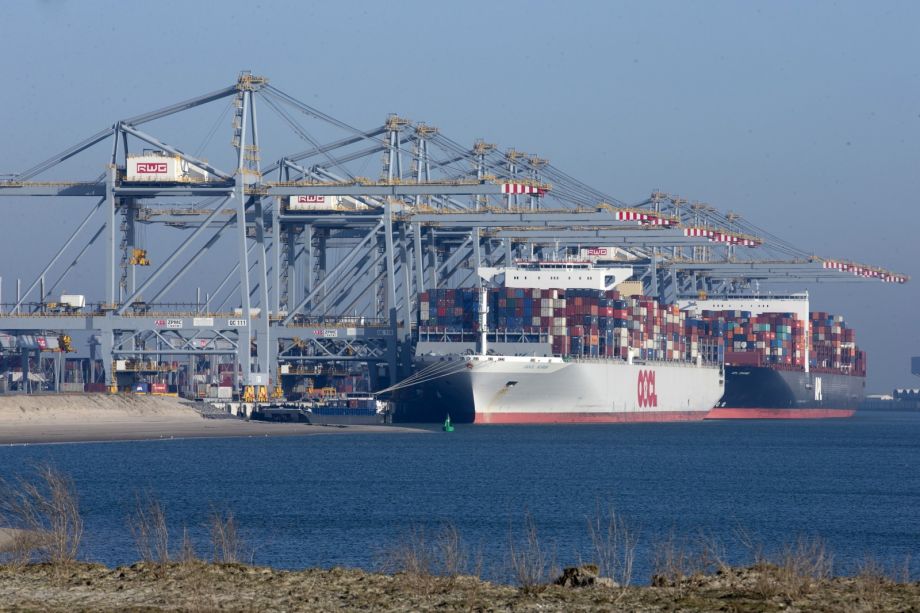Are You A Vanguard? Applications Now Open
This is your first of three free stories this month. Become a free or sustaining member to read unlimited articles, webinars and ebooks.
Become A MemberThe stack of the newest coal power plant in the Port of Rotterdam towers over the city. At 167 meters, the blue and gray behemoth soars 2 meters higher than the tallest buildings downtown.
Fired up in 2016, the Uniper Maasvlakte plant can generate 1,070 megawatts at full blast. Together with its elder sister, the 2-year-old 800-MW Engie Maasvlakte power plant, the two port coal plants emit 9.7 million tons of carbon dioxide (CO2), the main driver of climate change, a year at full capacity — as much as 3.5 million cars. If the plants weren’t so large, you could think of them as the progressive, environmentally conscious Dutch city’s dirty little secret.
Over the last decade, the metropolis of 630,000 people on the North Sea has pioneered a new approach to living with water, building stunning plazas that act as water retention ponds and preserving sponge-like green areas that soak up stormwater. For cities around the world, like New Orleans, Rotterdam is a model of sustainable design practices and the trendy “blue urbanism” movement that is driving cities to rip up the concrete from drainage ditches and daylight streams. It’s built an international reputation with its efforts to both mitigate climate change and adapt to rising sea levels, even funding a government official to advise the White House on post-Hurricane Sandy recovery.

Downtown Rotterdam (Photo by Jurriaan Snikkers)
But for all of its wins, the city has failed to do the one thing that actually would slow the pace of climate change: reduce its carbon emissions. Today, the city emits 42 percent more carbon dioxide into the atmosphere than it did in 1990 — 34 million tons per year now compared to 24 million tons then.
That wouldn’t be so surprising for a city in pretty much any other part of the world; emissions have climbed upward since 1990 on every continent, with the most dramatic rises in rapidly urbanizing regions of Asia, Africa and Latin America. But in the European Union where emissions are down 22 percent since 1990, Rotterdam is an outlier.
How one of the world’s most progressive and environmentally conscious cities became a weak link in the global battle against climate change is a story about politics, the siren song of technological innovation and the dangerous bets that are made when local decisionmakers are forced to kowtow to industry.
The story holds lessons for other global cities eager to reduce emissions yet unable (or unwilling) to abandon traditional ways of doing business.
The Port of Rotterdam is the largest in Europe and, the ninth largest in the world. It’s a huge driver of the local economy, generating more than 12 billion euros in direct value and employing 94,000 people, according to the latest available data on its website. Its industries also generate nearly 90 percent of the city’s emissions and account for 17 percent of the nation’s carbon footprint.
For that reason, it was hailed as visionary when the port came on as a partner to the Rotterdam Climate Initiative, the region’s main climate organization, a public-private partnership linking city government, the local and regional environmental protection agency and private sector partners. In 2007, RCI announced a plan to slash emissions in half by 2025, compared to 1990. It was an ambitious effort supported by a number of cutting-edge projects, including the expansion of district heating in the region, a drive to make the city’s transit system the cleanest in the world with renewable-energy-powered trolleys, and myriad other high-impact projects. The port came out publicly in support of the plan, vowing to radically shift its own operations to reduce emissions.
But there was one sticking point: coal. Two aging coal plants powered industry at the port and there were no plans to close them, despite pressure from environmentalists and sustainability-minded local officials.
In 2008, the Dutch cabinet approved port plans for two new massive plants, giving a green light even as critics, many of them in city government, warned that the new smokestacks would send emissions soaring. The rationale was geopolitical and outside the scope of city policy: The Dutch cabinet wanted to reduce reliance on natural gas imported from Russia.
“The city was certainly not unanimously in favor of the plants because of possible negative effects on air quality and our CO2 ambitions,” says Fred Akerboom, urban development program manager for the city. “We could not have stopped the power plants,” he says, although he acknowledges that the city could have created procedural delays.
In 2014, not long after construction began on the new plants, the city’s new center-right coalition government abandoned the RCI goal of cutting emissions in half by 2025.
But even as the coal plants moved forward and RCI plans were scaled back, some environmentalists held out hope. In approving the new coal plants, the Dutch cabinet had required certain measures to mitigate the plants’ emissions. One of those measures was the inclusion of experimental new power plant technology called Carbon Capture and Sequestration (CCS).
CCS at the time was seen by its promoters as the best of all possible worlds: a clever way to shrink the city’s carbon footprint without forcing coal power plants out of the port.
The seductive vision that supporters of coal power plants in the port espoused was that by capturing CO2 from coal and other fossil fuel-burning power plants, those industries could safely go on with their profitable fossil fuel business as usual while also reducing emissions to comply with the city’s climate policies. Supposedly the technology could tame the coal plants’ ferocious emissions to a fraction of what a cleaner natural gas plant would discharge. (Local air pollutants clearly would not be diminished by capturing CO2 though, nor would releases of the powerful greenhouse gas methane during coal production.)
Talk of emissions reduction made the large carbon pill the city was forced to swallow go down more easily. After all, the CO2 would all be safely stored forever in the empty gas fields just offshore in the North Sea through an offshore pipeline that had yet to be built. It sounded too good to be true — and it was.
In June 2017, the 500 million euro CCS program ended, not long after news broke that the city’s emissions had nearly doubled since 1990.
“The ambition of the Rotterdam Climate Initiative was always based on the idea that, despite the initiative, the city’s CO2 emissions would increase inexorably, although more slowly than under business-as-usual conditions,” says Chris Roorda, senior researcher with the Dutch Research Institute for Transitions. “Then CCS would magically come to the rescue and painlessly eliminate vast amounts of emissions. But, of course, industry in the port is not investing in CCS, because it is far too expensive and uncompetitive.”
The end of Rotterdam’s CCS experiment is widely regarded as a major setback for the technology and the larger “clean coal” industry.
The project collapsed in the same month that a major U.S. utility suspended work on that country’s largest CCS program. Southern Company threw in the towel on the clean coal project at its Kemper County, Mississippi, coal gasification plant after costs multiplied fourfold from $1.8 billion at the outset to $7.5 billion at the time of capitulation, becoming the most expensive power plant per megawatt in the U.S.

A section of the Mississippi Power Co. carbon capture power plant in De Kalb, Mississippi. Carbon capture entails catching the carbon emissions from a power plant or cement or steel factory and injecting them underground for permanent storage. (AP Photo/Rogelio V. Solis)
In an announcement on June 29, the Port of Rotterdam Authority expressed its disappointment in the Rotterdam cancellation plan and laid blame on the two companies operating the CCS-equipped coal plants, Uniper Maasvlakte and Engie Maasvlakte.
“Carbon capture and storage (CCS) is one of the key means through which coal-fired plants can reduce their CO2 emissions,” the statement reads. “The companies have failed to meet the expectations they had created with regard to a large-scale CCS pilot project.”
Holland’s economic affairs minister, Henk Kamp, said the government is studying the possibility of suing the companies to recoup subsidies paid for the project. Their withdrawal, he declared, wouldn’t be allowed to derail the nation’s commitment to developing CCS technology.
The allure of CCS is easy to grasp. It’s a process by which the combustion gases from a power plant or industrial furnace are collected and some of the CO2 is captured and pressurized. The compressed gas is then fed into a pipeline and transported to a permanent underground storage site. To date, CCS had been used to reinject CO2 from Norwegian oil field operations, but no large-scale CCS program has proven technologically and commercially viable for a large coal-fired power plant. Only a few CCS projects larger than pilot scale are in operation anywhere in the world today.
When Rotterdam replaced its two old coal power plants with the much larger plants, one of which is equipped with a CCS unit, the hope was that the technology would keep the plants within the city’s carbon budget. The port was (and still is) especially eager to reduce its emissions, officials say. Despite the strongest warnings from environmental researchers about the risks of depending on the unproven technology, city and port officials allowed the two new coal plants to be built on the theory that their emissions would be trapped by CCS and reinjected into a depleted gas field beneath the North Sea.
The Port of Rotterdam planned for a two-year CCS pilot project — to be subsidized by hundreds of millions of public euros — in which a quarter of the large Uniper Maasvlakte 3’s coal plant’s emissions in the port would be sequestered. The two power companies that owned the coal plants, Uniper and Engie, both were prepared to invest at least 100 million euros in the effort. The rest of the funding for the 500 million euro project was to have come from the federal government, the European Commission and the port.

Ships loaded with containers are docked at Euromax Terminal in Rotterdam's Maasvlakte port. (AP Photo/Peter Dejong)
Once funding was secured for the Rotterdam CCS pilot project, a consortium of 11 Rotterdam businesses began developing a regional CCS pipeline to link industries producing lots of CO2 to the potential offshore CO2 storage facilities. Known as the Rotterdam Capture and Storage Demonstration Project (ROAD), it was one of the world’s largest CCS demonstration efforts.
However, without aggressive action at Rotterdam’s port to expand and successfully commercialize the CCS system, environmental analysts warned from the outset that the city stood zero chance of achieving the green dreams it was promoting to the world.
CCS has a checkered past, with many technological failures. About a dozen European pilot projects have ended badly, and the technology has not been proven to be commercially competitive at the large scale needed to capture the emissions of a large coal power plant. Further, CCS has proven to be uncompetitive with clean energy technologies like solar and wind power, which produce no combustion products and whose costs are falling rapidly.
Unlike wind and solar, CCS requires significant amounts of energy to compress, transport and store captured CO2, which also reduces the power plant’s electrical output. The addition of CCS to a power plant also requires lots of water for cooling, which is not always readily available. In short, CCS equipment, pipelines and noncommercial storage site investments are pricey extra expenses for a power company. Geological storage, for example, has to be monitored indefinitely to prevent CO2 leakage, which would defeat the purpose of CCS.
Another problem is that CCS technology typically does not capture all of the combustion emissions a coal power plant produces, so up to 10 percent of the CO2 produced is released even when the technology is installed and working properly.
Rotterdam’s CCS pilot was designed to capture 25 percent of the plant’s CO2 emissions at best. The attainment of the Rotterdam Climate Initiative’s original 2025 emissions goal would have required a fully deployed, commercial-scale CCS system that was by then capable of avoiding 17.5 million tons of CO2 per year. The city’s pilot project was initially designed to capture 1.4 million tons of CO2 a year, according to port data.
Today, without an operational CCS, the Rotterdam plants, when operating at full capacity, generate 9.7 million tons of CO2 per year, about 50 percent more than the older plants. Though these emissions undermine the port’s stated goal of being the most sustainable port in the world, according to its website, the port is still officially committed to reducing CO2 emissions by 20 percent in 2020, 50 percent in 2030, and 80 percent in 2050, relative to 1990.
Meanwhile, when I visited the city in 2015, the city’s former climate program director told me that the city had “no target on CO2 emissions at the moment.” The city instead had decided to focus on air quality, noise pollution, energy efficiency and other measures of sustainability, which in themselves tend to lower emissions.
Despite all the setbacks, CCS has not lost its allure to Dutch officials and others searching for clean energy solutions. “We are convinced CCS is essential to meet the Paris agreement,” says port spokesman Sjaak Poppe, referring to the 2015 UN accord committing all the world’s countries to reducing greenhouse emissions. For some industries, “100 percent sustainable technologies are not available at the moment or not applicable yet on a large scale,” he says. “Especially for these industries, CCS is a way to reduce CO2 emissions while producing the materials demanded by society, including those that are needed to make the [clean energy] transition. … Therefore we are determined to go ahead with CCS.”
It’s a point echoed by Akerboom, the city’s urban development manager. “CCS is still on our agenda,” he says. “It still is necessary in the transition path towards a zero-carbon industry and city. Especially for those industries that need more time for transition and that are vital for our future, like chemical industries, waste incinerators, etc. Our port authority is working on it.”
Defenders of CCS can point to a few locations, mostly in conjunction with oil drilling operations, where the captured CO2 has been injected into the ground to recover additional oil left behind during conventional drilling. But because the costs have been high and the benefits few, the private sector has been reluctant to install CCS equipment and, as in the Rotterdam case, it has generally only done so with heavy government subsidies.
In certain special situations, however, for example, when a pure stream of CO2 is produced in the chemical industry, it could make economic sense — and sense from a climate perspective — to capture that CO2 and inject it into a storage facility. European governments could sweeten the deal by providing subsidies or imposing higher carbon taxes.
The Netherlands has an international reputation as a model progressive society and it actively cultivates that impression, but the reality is not always fully aligned with that image when it comes to the country’s current energy and climate policy.
In a sense, Rotterdam appears to be a microcosm of a Netherlands that is not speaking with one voice on the need to bring down greenhouse gas emissions. The country has assertive national energy efficiency and pro-renewable energy incentives yet remains 92 percent dependent on fossil fuels, and its per capita emissions are among Europe’s highest. Proposals for new wind farms often elicit powerful opposition, and the country’s liberal-conservative party has not wanted to support a compulsory carbon tax. Yet paradoxically, the Netherlands is committed to reducing its CO2 emissions by 80 to 95 percent by 2050, and Minister Henk Kamp was instrumental in mobilizing a coalition of all North Sea nations to agree to get 80 percent of their energy from renewables by midcentury.
The government also reached an Energy Agreement for Sustainable Growth in 2013 with 40 major stakeholders, including industries, unions, environmental organizations, and other governments to begin reducing national energy use by 1.5 percent per year. It was followed by a series of important national energy agreements aimed at reducing emissions and culminating in 2016 Energy Agenda: Towards a Low-Carbon Energy Supply. The Energy Agenda describes the choices to be made and steps to be taken to achieve a low-carbon energy supply in 2050 — one in which the energy supply would be virtually entirely sustainable and carbon emissions would be reduced by 80 to 95 percent of 1990 levels.
Political opponents in Rotterdam, however, attack the city’s climate initiative for investing municipal funds to address global issues. With the delay and possible loss of the CCS option, Rotterdam will need to act decisively if it wants to fulfill its dream of being one of the world’s most admired sustainable cities.
EDITOR’S NOTE: The original article included incorrect information about the size of the Port of Rotterdam and the environmental agency engaged in the Rotterdam Climate Initiative. We’ve corrected these statements and additionally, clarified the amount of money budgeted for CSS technologies at the port.
John J. Berger, PhD. is an energy and environmental policy specialist who has produced ten books on climate, energy, and natural resource topics. He is the author of “Climate Peril: The Intelligent Reader’s Guide to the Climate Crisis,” and “Climate Myths: The Campaign Against Climate Science,” and is at work on a new book about climate solutions.

20th Anniversary Solutions of the Year magazine